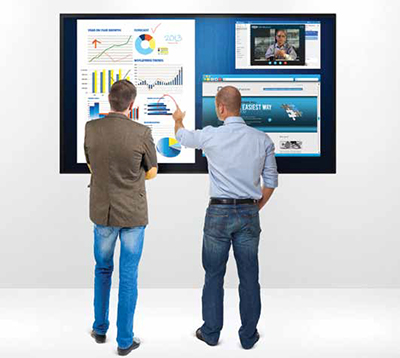Trends in Outsourcing Digital Signage Management

Planar’s UltraRes Touch is part of the portfolio of 84-inch ultra HD (3840 x 2160) LCD displays with native 4K resolution. Since the dawn of the digital sign, companies have used signage networks to communicate with employees and end-users. While this has proven effective for many organizations on an anecdotal level, it’s often challenging to assign hard numbers to the ROI of digital signage.
“What IT managers need to consider is the fact that there is going to be an investment in hardware, and that investment is not necessarily going to have any type of return on it,” said Dave Haar, vice president of digital signage solutions at Kramer Electronics USA. Most inward-facing digital signage networks are used for things like training and information dissemination, which are not easy things to measure in terms of dollars. “They may get more productivity, they may have fewer accidents because they’re doing safety messages, and they may have more participation in company events, which could improve morale, which could improve productivity. But the content needs to be maintained, and there are going to be stakeholders.”
ROI can be just as difficult to measure when digital signage is outward-facing, notes Raffi Vartian, chief operating officer at Signagelive. “It really depends on what people are using their networks for,” he said. “If I’m McDonald’s and I’ve got a menu board up there, it must be up when people come to order or people will not order things, so it has a direct financial impact.” If, however, a corporate office has a display running CNN in its lobby, it doesn’t have the same impact on the company’s bottom line. “The ROI per screen is so wildly variable.”
“Digital Signage Industry Status & 2014 Outlook,” published by the research and analysis firm Bunn, notes that over 400 independently owned and operated advertising-based networks exist in North America. The firm estimates that 18 million displays represent “owned” media for companies utilizing digital signage for visitors, shoppers, and travelers, as well as for internal communications for staff and, within educational institutions, for students. There is strong evidence that these numbers will continue to rise; Bunn declares that for those working in the digital signage sector, 2014 is going to be a good year.
Digital signage may well be on its way to becoming ubiquitous. However, given that its impact can be challenging to quantify, how can companies best allocate the resources they devote to creating and maintaining digital signage? And how best to find a balance between in-house development and hiring outside experts?

The Black Box VideoPlex4 Video Wall Controller outputs 1080p DVI video to multiple monitors, splits a single DVI input into four independent monitor, and can support edge-blending projectors for image overlap. A digital signage system requires network management, content creation and updating, and scheduling. In a sense, it’s a miniature broadcast operation. “There are very few organizations that are completely self-sufficient when it comes to running their digital signage networks,” said Dave Haar. Most companies form partnerships with specialists that may manage all, or part, of the puzzle. “That could be on the deployment side, or on the content creation or management side, or they may be using one of the partners out there that do Software as a Service (SaaS) and do the hosting of the content.”
For those organizations that want to manage some portion of their digital signage inhouse, it then becomes a question of which part would be best for them to handle. For Haar, it comes down to content. “If we assume that the success of the network is based upon the messaging, then the most logical aspect of the digital signage network to take in-house is the actual creation and maintenance of the content,” he said, “because an organization knows what it wants to accomplish with the digital signage network that it wants to put in.” And the people that best know their audience, Haar reasons, are best equipped to target the messaging.
A daily selection of features, industry news, and analysis for tech managers. Sign up below.
Taking digital signage in-house requires resources— specifically, human resources, warns Raffi Vartian, chief operating officer at Signagelive, a developer of cloud-based media delivery solutions in Evanston, Ill. “Those that have the ability to take it in-house have bodies, have humans, that can actually do the work,” he said. “Digital signage is a product you have to manage. The cheapest a digital signage network ever is, is when you buy it, but the cost never ends because you have to keep feeding it.” Otherwise, he says, it’s like having a TV in your home, but no cable package to support it. “The companies that can take it in-house have a least one or two full-time people that can look after it.”
Another issue is that digital signage—especially when it comes to content—isn’t something that falls solely under the IT department’s realm of expertise. Depending on what message you are trying to deliver, there may be a number of different players involved from throughout the organization, including human resources, marketing, and sales. While this requires a considerable coordination effort, if the workflow is designed properly it could actually ease the burden of keeping content fresh. “There are all sorts of different departments within an organization that could contribute to the maintaining and the refreshing of that content so that they’re not showing the same message day in and day out, week after week,” Haar said.

Planar’s UltraRes Touch But while bringing more people into the mix may result in fresher content, Hussain Ali, principal at Houston Dynamic Displays (HD2), reminds us that these people will require time to create the content. “One of the most important aspects of taking digital signage or any other project in-house is the time consideration,” he said. “People really underestimate the time that is required to plan, the time that is required to deploy and the time that is required to have an ongoing presence of that technology.” Content creation and management, technology support and eventual — and inevitable — upgrades all take time, as does the planning associated with these functions so that the process is as streamlined as possible. “It’s about [accounting for] that time, which is unfortunately very sacred in a lot of organizations.”
Ali also urges organizations, whether their digital signage is managed in-house or not, to make time to properly test the systems before going fully live. “I think it’s important for organizations that are thinking about getting into digital signage to have some sort of plan for a pilot project so that they can test the hardware, the software, and then refine their communication message,” he said. “The reason you’re doing this is because you want to improve communication, so it’s important how that refined message gets to your audience.”
Vartian points out that as a digital signage network becomes larger and more people are required to manage it, this staff needs to be highly skilled. “Almost everyone that runs large networks has a hosting company or a managed services company in the background doing proactive monitoring, call support and everything else,” he said. To him, it makes much more sense to outsource the management of digital signage systems to specialized firms that offer these services. “It’s a classic outsourcing versus hiring scenario,” he said. “It really makes more sense to bring in an organization that understands this business. It’s a much more viable business model and network strategy than hiring your own people.”
In the end, each organization must weigh the many determining factors and chart their own course. Whichever way they go, the results will be on digital screens for all to see.
Carolyn Heinze is a freelance writer/editor.
info
Houston Dynamic Displays (HD2)
www.houstondd.com
Kramer Electronics USA Inc.
www.kramerelectronics.com
Carolyn Heinze has covered everything from AV/IT and business to cowboys and cowgirls ... and the horses they love. She was the Paris contributing editor for the pan-European site Running in Heels, providing news and views on fashion, culture, and the arts for her column, “France in Your Pants.” She has also contributed critiques of foreign cinema and French politics for the politico-literary site, The New Vulgate.
